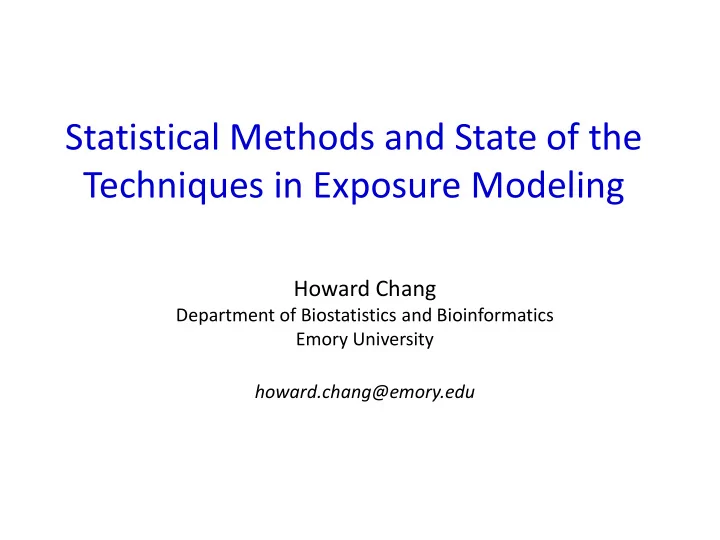

Statistical Methods and State of the Techniques in Exposure Modeling Howard Chang Department of Biostatistics and Bioinformatics Emory University howard.chang@emory.edu
Different Exposure Modeling Goals • Estimate exposure retrospectively • Linkage with health data Past • Health + exposures measured together • Dimension reduction Current • “What if” assessment • Quantifying uncertainties Future
Representative Statistical Methods • Data fusion Past • Source apportionment Current • Climate projection bias-correction Future
A. Data Fusion Assimilation, Integration, Calibration, Melding, Blending Proxy Data Computer model output Observation Satellite imagery measurements Stochastic simulation Land use/meteorology • Long-term or short-term pollutant predictions • Uncertainty measures
Computer Model versus Satellite Retrievals Computer Model Satellite Pollutants Major pollutants PM 2.5 , NO 2 , SO 2 , CO, O 3 Resolution 4 ~ 50km gridded 1 ~ 25km pixel Frequency Hourly 1 or 2 samples/day Incorrect inputs Not ground-level Why biased? Chemistry Retrieval error Discretization Missing data Availability Open Source Publically available Computation Heavy run time Post-processing
Statistical Data Fusion (Downscaling) For day t at monitoring location s : Space-time additive bias 𝑷𝒄𝒕 𝒕, 𝒖 = 𝜸 𝟏 𝒕, 𝒖 + 𝜸 𝟐 𝒕, 𝒖 𝑸𝒔𝒑𝒚𝒛 𝒕, 𝒖 + 𝜻 (𝒕, 𝒖) Space-time multiplicative bias
Data Fusion Example: CMAQ
Spatial Bias in CMAQ Additive Multiplicative 37 37 0.20 1.5 36 36 0.15 1.0 0.10 35 0.5 35 Latitude Latitude 0.05 0.0 34 34 0.00 -0.5 33 33 -0.05 -1.0 32 32 -0.10 -1.5 31 31 -0.15 -86 -84 -82 -86 -84 -82 Longitude Longitude
Predicted Concentrations 2004-01-01 2004-07-01 Calibrated Calibrated 37 37 16 36 36 25 14 35 35 34 34 12 33 33 20 32 32 10 Latitude 31 Latitude 31 Raw Raw 37 15 37 8 36 36 35 6 35 10 34 34 4 33 33 32 5 32 2 31 31 -86 -84 -82 -86 -84 -82 Longitude Longitude
Does Data Fusion Help? Asthma Emergency Department Visits in Atlanta CMS = Central Monitor PWA = Spatial Kriging + Population Weighting FSD = Data Fusion + Population Weighting
B. Source Apportionment UNOBSERVED OBSERVED single- pollutant mixture pollutant concentrations (20+) Biomass Burning Traffic Dust/Soil Both the sources and the profiles are unknown .
Example Source Apportionment Change in FEV1 associated with each interquartile (a) immediately after commutes (b) 1h after commutes (c) 2h after commutes (d) 3h after commutes Golen et al. In prep
Source Apportionment Methods Chemical Mass Balance Assume profiles known Numerical optimization Gas-/marker constraints Cannot empirically validate results! Latent Variable Assume profiles unknown + label latent variables Absolute principle Component Positive matrix factorization Bayesian factor analysis
Variability Across SA Methods BIOMASS BURNING SOC, July 2001, Equal Weighting 10 CMB-RG CMB-LGO PMF 9 CMB-MM CMAQ 8 Source Impact ( g m -3 ) 7 6 5 4 3 2 1 0 5 10 15 20 25 30 July 2001
Ensemble-Trained Source Apportionment CMB-GC Biomass Burning CMB-MM PMF CMAQ Balachandran et al. Env Sci Tech 2013; 47: 13511-13518 Gass et al. Am J Epidemiol 2015; 181: 504-512. 15
Data Fusion for Source Apportionment Winter Biomass Burning Adjusted - Original Original Adjusted Summer Coal Combustion Adjusted Original Adjusted - Original Ivey et al. Geosci Model Dev 2015 ; 8: 2153-2165. 16
C. Bias-Correction for Climate Model Climate Model Simulations Hydrological Model Air Quality Model Disease Transmission Model 17
Quantile-Mapping 0.20 Hindcast Period 𝐃𝐦𝐣𝐧𝐛𝐮𝐟 𝐍𝐩𝐞𝐟𝐦 𝐔𝐟𝐧𝐪𝐟𝐬𝐛𝐮𝐯𝐬𝐟 0.15 𝐏𝐜𝐭𝐟𝐬𝐰𝐟𝐞 Temperature Density 0.10 0.05 0.00 15 20 25 30 18
Future Projection (2041-2070) 19
Health Impacts with Bias-Correction Bias-correction reduces between-model variability Chang et al. Atmos Env 2014; 89: 290-297. 20
Advances in Statistical Data Fusion • Multiple pollutants • Proxy “features” • Multiple proxies • Stochastic proxies • Methods for massive spatial datasets
Additional Remarks What method to use depends on: • Study design • Health outcome • Exposure of interest New and better data products are being developed and often are publically available. Lots of research activities but limited comparison and synthesis. 22
Recommend
More recommend